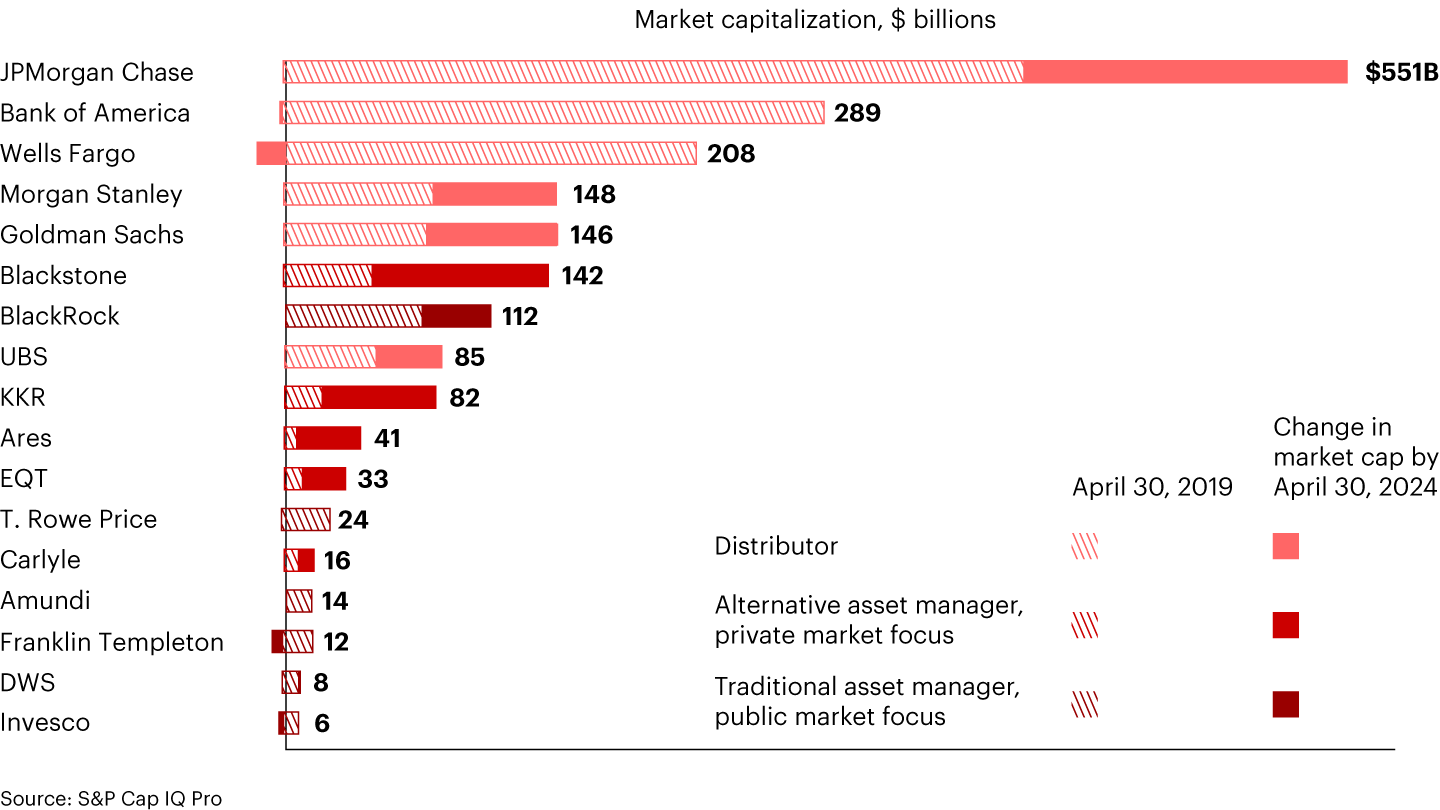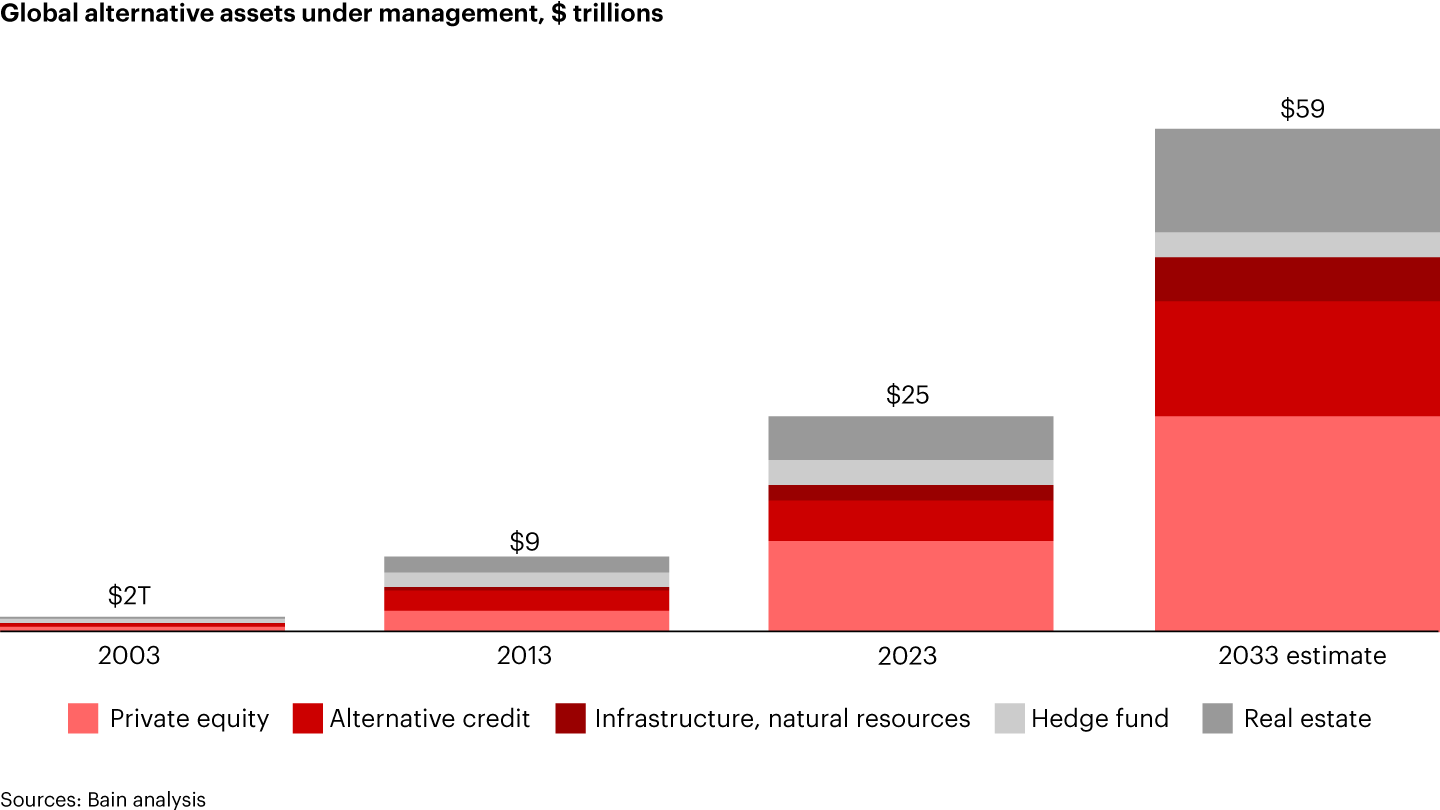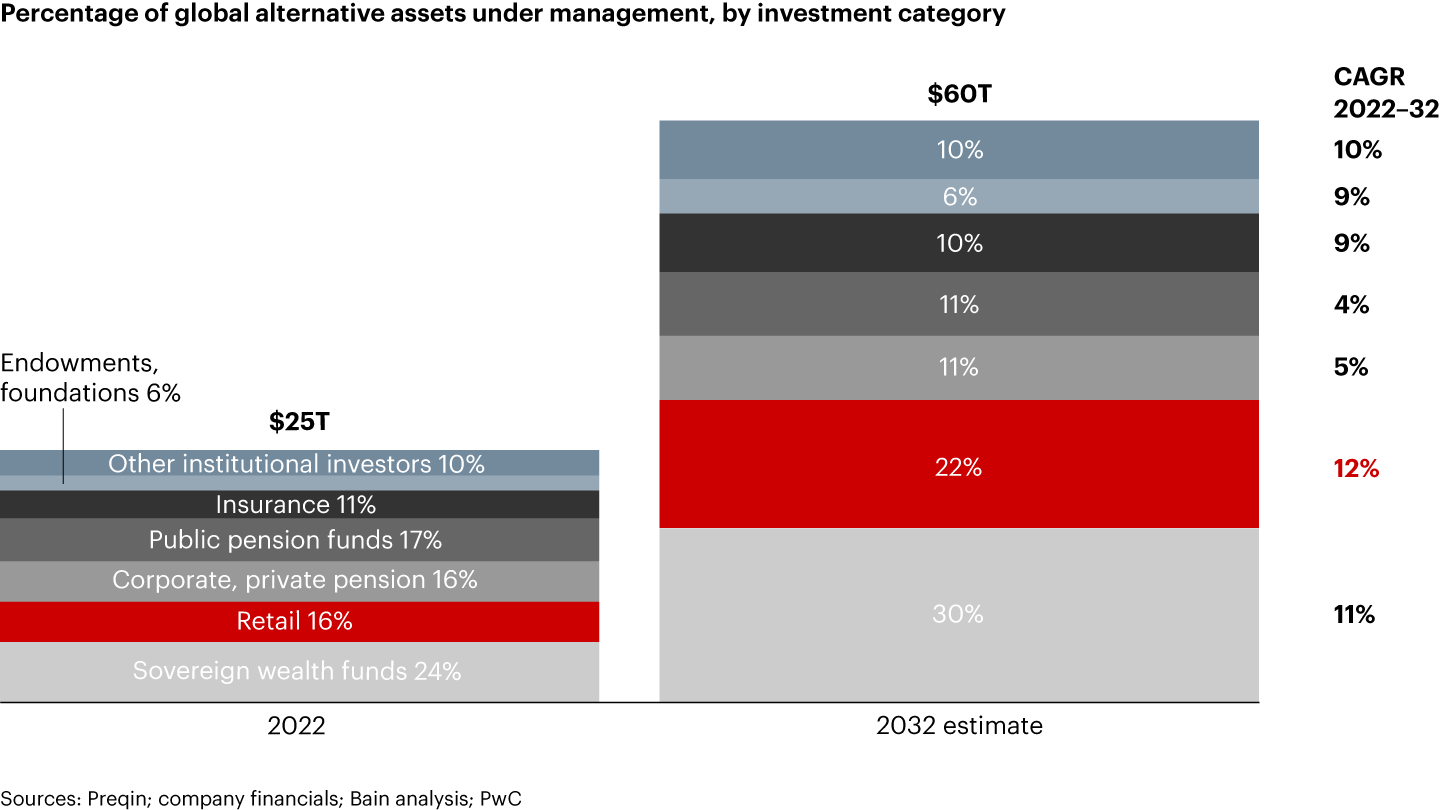Brief

Executive Summary
- Private markets appeal to more wealth and asset management firms as profit margins shrink elsewhere.
- Companies are either offering niche products that generate alpha or building scale in production or distribution.
- However, the business of private markets requires different capabilities than management of public assets.
- Companies need to anticipate changes in strategy, capabilities, investor education, sales and marketing, and M&A integration.
Many asset management and wealth management firms have embraced private markets. The firms that emphasize alternative asset production and distribution have been rewarded by investors with higher market capitalization than most of the firms that focus on publicly traded assets (see Figure 1). Although private markets are not the sole reason for the higher market capitalization, they are an important part of the equation.


Private markets have come into favor because the business models that have dominated asset management for years have nearly run their course. Profit margins have compressed, with the average profit per assets under management dropping from 15 basis points in 2007 to 8 basis points in 2022 (see Figure 2). Many firms have reduced management fees, causing median revenue to drop by 4% from 2021 to 2022, according to Casey Quirk.


Differentiation also has dwindled, with eVestment estimating low dispersion in returns (1% to 2%) as well as fees (4 to 6 basis points) in public equity investments between top- and bottom-quartile management firms. That decline has prompted management firms to shift to low-cost beta trackers, and passive investments are expected to grow in share.
The appeal of private markets
An emerging model that emphasizes alternative private markets holds promise, but companies will need to develop a slew of new capabilities to secure a firm foothold.
Private assets constitute a much larger market than public assets and offer potentially higher yields, diversification, and in cases such as real estate, a hedge against inflation. Fewer companies have been going public in recent years, with global initial public offerings falling 45% from 2021 to 2023 due to increased regulation and higher costs. By contrast, we estimate that private market assets under management (AUM) will grow by a nearly 9% compound annual growth rate (CAGR) through 2033, more than twice the rate of public market AUM (see Figure 3).


In parallel, fee revenue for private market investments, at $0.9 trillion in 2022, should double to $2 trillion by 2032. Private equity and venture capital will continue to be the largest categories, with private credit and infrastructure investments expanding into sizable asset classes.
Alternative credit has already grown at a 7% CAGR from 2012 through 2022, and we expect it to expand at a 10% to 12% CAGR by 2032. This accelerated pace largely reflects banks issuing fewer loans.
Robust infrastructure growth―at a 16% CAGR over the past decade―will maintain a 13% to 15% CAGR pace over the next decade. Growth here stems from a shortage of public funds as government deficits widen.
Investor demand has picked up as well, with other institutional investors expected to increase their allocation to alternative assets by a 10% CAGR from 2022 to 2032, which will cause AUM to reach at least $60 trillion (see Figure 4). Sovereign wealth funds, endowments, and insurance funds are seeking higher yields due to public market volatility and declining returns. Similarly, rising contributions from retail investors will cause the retail AUM share to rise from 16% in 2022 to 22% in 2032. Individuals are drawn to the alternative asset market by the prospect of diversification and higher returns and are willing to tolerate lower liquidity.


In response to this retail demand, some companies have launched innovative offerings, such as intermittent liquidity products characterized by periodic redemption. Blackstone and KKR, for instance, have both launched private market funds with monthly or quarterly repurchase frequency.
Recent moves on the chess board
Traditional asset manager firms’ share of alternative assets increased from 16% in 2018 to 22% in 2022, as the firms sought diversification and better risk-adjusted returns. Some of the firms have made acquisitions to expand their product range, while others have expanded organically, such as Fidelity launching 18 alternatives products in 12 months. These firms also are expanding their position across the value chain to wealth management, such as BlackRock’s joint venture with Jio Financial Services in India to provide direct digital investment solutions via Jio’s local distribution network.
Turning to private banks and wealth managers, many have been expanding to tap into client demand and higher fee income. Select firms are penetrating deeper into retail clientele with their own manufactured assets. Some have hired experienced advisers and wealth managers to target wealthy individuals.
Alternative asset managers and private equity firms, for their part, have also broadened their portfolios of alternative assets. Others have been attracting retail investors by offering evergreen products (with no fixed end date), following difficulties raising funds from institutional clients and ensuring dependable revenue streams from fees.
Stepping back, we observe a convergence in strategies among traditional and alternative asset managers, with many gearing up to become full-service providers across asset classes, investor types, and value chain positions. This will intensify competition in the market, with dominant firms likely relying on two tactics:
- offering a niche product that generates alpha, such as environmentally sustainable products in infrastructure for ultra-high-net-worth individuals;
- developing large scale in production, including product creation and testing; distribution, including reach and conversion; or operational efficiencies, including risk management and compliance.
Many companies of all kinds have already started to pursue one of these approaches, and some companies are using both avenues to maximize their results.
What it will take to adapt
The transition to private markets poses significant challenges, given the differences between retail and institutional investors. Firms will need to add or develop new capabilities around their technology systems, sales and marketing approaches, and investor education. To close the gaps, some companies might rely on acquisitions, but many acquisitions fail to deliver the anticipated benefits due to cultural differences or ineffective integrations. And with talent scarce in certain fields such as data science, it can be tough to recruit and hire enough people with the necessary skills.
As companies consider how to expand into alternative assets, they should anticipate making changes on the following fronts:
Define where to play and how to win. It may sound obvious, but before making any moves companies first need to understand their starting point and ultimate ambition for private markets.
Develop new front-to-back-office capabilities. This can be accomplished through salesforce training, onboarding product specialists, and redesigning operations, technology, risk, and legal processes. Such activities will help bridge the differences between, say, a system for valuing private assets and one for public assets. One global insurance asset manager, for instance, wanted to improve its private equity portfolio performance, which had been outsourced. After conducting a detailed portfolio review and a survey of competitor strategies, the company built new capabilities, taking care to limit changes to structure and team size. The new in-house capability for fund selection brought a 400-basis-point improvement in its internal rate of return.
Educate investors about risks and liquidity for alternative assets. Companies will need to communicate how investors can have sufficient liquidity and the ability to collateralize private assets; that minimum investments and onboarding are more accessible than commonly perceived; and that reporting and tax filing processes have become more streamlined.
Adapt sales and marketing. New digital platforms and other distribution channels will be required to heighten brand awareness, raise funds, and offer a broader array of assets. Companies will need to hire and train sales representatives adept in developing relationships with wealth managers and explaining complex products to retail clients. One financial services company was experiencing falling revenue, AUM, and customer count because of stagnant sales team productivity. A new training program and performance metrics for advisers led to a twofold increase in customer acquisition and a 70% increase in new AUM per adviser.
Improve M&A integration skills to blend talent, culture, and operations. Deal activity in private markets has accelerated since 2020, with more than 40 transactions in each of the past three years. Most recently, traditional investment firms have announced a few notable acquisitions and partnerships, such as BlackRock purchasing Global Infrastructure Partners.
* * *
During this transitional period when demand for private market assets is surging, retail investors are still forming preferences for brands and products. Regardless of their current position in the market, companies have an opportunity to shift their approach and broaden their offerings, if they can develop the right capabilities, systems, and mix of talent to capture that demand.